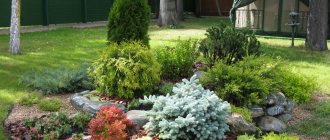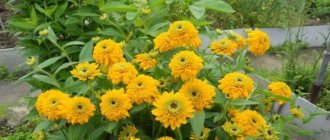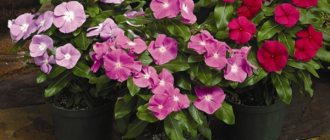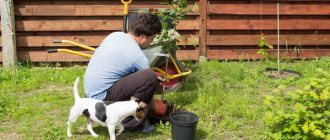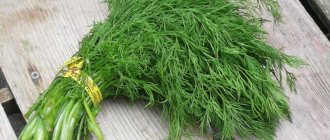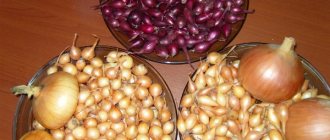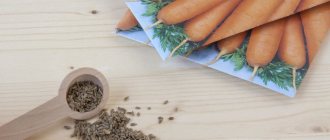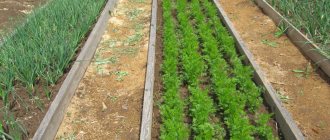Main types of thyme
Among the huge number of thyme species, the following stand out:
- Ordinary. Came to us from southern France and Spain. It is distinguished by small, lanceolate leaves of a dark green color and pale lilac flowers.
- Creeping. Mediterranean species with leathery leaves of various colors. The purple flowers have a beautiful pink tint. This thyme is resistant to frost and drought and is considered an excellent honey plant.
- Lemon-smelling. A hybrid species from southern France, so named because of its tart lemony smell. Yellow leaves turn green over time. The flowers are a pleasant pink color. Does not tolerate frost well, requires shelter during the cold season and regular pruning.
- Vegetable Honey. Heavily leafy, perennial hybrid is resistant to drought and cold, and produces high yields. A wonderful honey plant and garden decoration. Used fresh and dried, in cooking and folk medicine.
Varieties for growing at home
All edible varieties are suitable for growing thyme at home in a pot. This information is indicated in the description of the plant, which is located on the back of the package. The most commonly used are the following:
- Ordinary. The most common. Forms low dense bushes. It has a strong odor and slightly pungent taste.
- Citric. It has a pleasant lemon scent and slightly pubescent leaves.
Methods of growing in the country
Growing thyme in your garden is not difficult. To do this, prepare seeds, cuttings or divide the bush. It is necessary to take into account active propagation by self-seeding, as a result of which, over time, it will be necessary to limit the space.
Thyme from seeds
Sowing seed material is possible in an area that has been thoroughly cleared of weeds. Since small seeds hatch within a month and develop very slowly, weeds interfere with the process. Therefore, it is preferable to grow thyme using seedlings. To do this, at the beginning of spring, a soil mixture of sand and peat is prepared, which is poured into boxes, trays or containers. The sown seeds are kept under polyethylene or glass until sprouts appear. Seedlings require regular moderate watering and good lighting. After 3–4 weeks, the plants, which look stronger, are hardened off in the open air for two weeks, after which they are planted in a permanent place of growth.
See also
Description of the Medok thyme variety, cultivation features and careRead
Thyme from cuttings
In summer, green cuttings are used to propagate thyme. This method is characterized by successful rooting. The procedure is carried out before flowering begins. The upper parts of the stems should be cut to a height of 10 cm, placed in river sand and covered with a piece of polyethylene. A month later, the rooted specimens are planted in open ground.
When dividing the bush, the base is broken and the roots are carefully untangled.
It is recommended to cover the plots with a glass jar for a week in order to increase survival rate.
Reproduction methods
Along with the seed method, thyme is propagated using cuttings and dividing the bush. These options are suitable if there is already at least one plant bush on the site.
Related article:
Thyme plant: photos, types, medicinal properties and contraindications
Cuttings
In the spring, when the shoots grow back and do not have time to become woody, they are cut off, planted in a loose substrate (sand + peat), poured into a plastic cup, and watered. The glass is covered with a bag, a jar and kept in a warm place with diffused light. After 7-10 days the package is removed. After about a month, the root system will form, and the seedling is transplanted into the ground.
Planting thyme
Growing a hardy and unpretentious subshrub will not cause trouble for the gardener. Bogorodskaya grass adapts to the proposed climatic conditions and, if treated correctly, responds by forming a spherical bush and increasing its useful mass.
Selection of location and soil
To plant thyme, you need to choose a place in the garden that is open to sunlight, but without drafts. The soil should be neutral and well drained. Heavy, clayey and highly moist soils require the addition of sand. In order for the grass to feel good in open ground, acidification must not be allowed, for which chalk or lime is added.
It is necessary to take into account the overall design of the garden so that the luxurious interweaving of thyme fits harmoniously into the landscape.
When and how to plant thyme?
Thyme seeds are planted in autumn and spring after soaking in warm water for 12 hours. The seedlings are thinned out, maintaining an interval of 30 cm.
It is best to plant seedlings after frost ends, on a warm, sunny day. A spacious hole is being built. The seedling is removed from the container and placed in a mixture of soil and sand. The surface of the soil is compacted, after which the plant is watered. When propagated by cuttings, planting is carried out in August.
When planting thyme in open ground with seeds, the subshrub will flower in its second year of life.
Planting thyme for seedlings
What time to sow seedlings
Thyme seeds are sowed for seedlings in mid-March. Since the seeds are very small, before sowing it is recommended to combine them with river sand in a ratio of 1:3. The container is filled with soil mixture for cacti, and a third of the black soil must be added to it. After this, the seeds are evenly distributed on its surface. For sowing, you can also use a substrate consisting of peat and sand (1:1), but it must be disinfected. There is no need to bury the seed into the soil mixture; it is only covered with a thin layer of sand on top. Then the crops are carefully watered with a fine sprayer, and the container is covered with glass on top and placed in a well-lit and warm place.
Rules for growing seedlings
Seedlings must be grown indoors for at least 8 weeks. It is best to plant plants in open soil at the age of 70 days. After the seedlings appear, they are placed in a cooler place, and the glass is removed. Watering is carried out using a sprayer immediately after the top layer of the substrate has dried a little. The room where the seedlings are located must have good ventilation, but they must be protected from drafts.
Thyme or thyme - how to grow seedlings from seeds and plant (thyme thyme or thyme)
Growing on a windowsill
Thyme can be grown indoors. To do this, you will need a pot with a diameter of no more than 15 centimeters; at its bottom you need to make a drainage layer, the thickness of which should be from 20 to 30 mm. The drainage from above can be covered with a layer of soil mixture (see composition above). The soil mixture must be moistened, and several seeds must be evenly distributed over its surface; the top should be covered with a half-centimeter layer of substrate, which is then moistened with a spray bottle. The container is covered with film or glass, then it is placed on a south-facing window, while the crops are protected from direct rays of the sun. The seed material has good germination. After the seedlings appear, the shelter must be removed. Watering should be moderate, it is carried out after the top layer of the substrate has dried. After 8 weeks, all weak seedlings must be removed, only the most developed ones should remain. To get fragrant and fresh greens for as long as possible, you need to cut them often enough, and try to prevent the bushes from blooming.
Rules for caring for thyme
Due to the unpretentiousness of the plant, there is no need to create special conditions for cultivation. Agrotechnical measures include watering, weeding, and loosening.
Features of watering
It is easier for thyme to withstand drought than waterlogging, which leads to rotting of the roots. Therefore, watering is indicated only in case of a prolonged dry period. On rainy days, the soil around the seedling is mulched with gravel, crushed stone, and sawdust.
Plant nutrition
Growing thyme does not require large amounts of fertilizer. If you fertilize the soil with humus before planting, this will be enough for the whole year ahead. Then, annual feeding with liquid mineral fertilizers is carried out in late spring or early summer.
It is advisable to use wood ash, which enriches the soil with minerals and reduces acidity.
Thyme pruning
Thyme pruning includes: shortening shoots and removing faded inflorescences. The shoots are trimmed to two-thirds of the length of the stem; this will maintain an attractive appearance and provide the plant with solidity. It is not necessary to prune bushes for the winter.
Pinching the stem will provide thickness to the adult thyme.
Creeping thyme: varieties, varieties
During the summer months, Bogorodskaya grass delights with its flowers. This plant looks great in a summer cottage and as an element of landscape design. Different varieties of thyme have their own characteristics:
- Silver Queen has fairly tall stems that reach 20 cm. The leaves are dull green with a white edge. The inflorescences are close to each other and have a pale lilac hue.
- Colchis is a fairly low-growing shrub that forms a beautiful decorative carpet with lilac flowers.
- Donna Valley has its own peculiarity - leaves with a yellow edging and pink inflorescences of different shades.
Diseases and pests
The aromatic substances released by thyme in large quantities serve as good protection against pests. Violation of the rules of care can provoke an insect attack.
See also
Growing, planting and caring for lemon thyme (thyme) from seedsRead
Significant damage to the plant is caused by:
- Meadow moths attacking stems and leaves. Activated on warm nights. Treatment with insecticides helps.
- Sand sluggers completely destroy above-ground organs. They are fought with poisoned baits.
- Weevils. They feed on young shoots and flower buds. Plantings can be protected by treating them with insecticides or installing baits with toxic drugs.
- Aphids attack the stems and leaves of thyme. Does not tolerate insecticides.
Preventive measures to protect against pests and parasites include: regular loosening, timely removal of weeds, deep digging and application of alkaline fertilizers.
Properties of thyme: harm and benefit
Medicinal properties of thyme
The above-ground part of thyme has healing properties. Infusions and decoctions with antimicrobial, enveloping and expectorant effects are prepared from it; they are used to treat whooping cough, tracheitis, sinusitis, bronchitis, tonsillitis, sinusitis, bronchopneumonia. Such drugs help to liquefy mucus and stimulate the activity of the bronchial glands.
Preparations made from thyme are recommended for use for neuroses, neuralgia, diseases of the gastrointestinal tract (enterocolitis, dysbacteriosis, dyskinesia, atony, intestinal spasms and flatulence). This culture has also shown high efficiency in the fight against pathogenic microflora, which is insensitive to antibiotics. If you use a pillow filled with thyme to sleep, then headaches and insomnia will no longer bother you. The composition of such herbs includes bitterness, gum, essential oil, tannins, organic pigments and minerals. Essential oils “white thyme” (fresh) and “red thyme” (aged) have a warming effect on the skin; they are used for cosmetic and medicinal purposes. But when using such products, you must strictly adhere to the instructions and dosages. It is best to consult with a qualified specialist.
The healing properties of THYME (Thyme) - a natural stimulator of the body's defenses!
Contraindications
Since the herb contains a large amount of thymol, it cannot be used for heart and kidney failure, stomach and duodenal ulcers, especially in the acute stage of the disease. During pregnancy, this herb is also contraindicated because it can cause uterine contractions. With prolonged use of thyme preparations or in case of overdose, there is a high probability of developing hyperfunction of the thyroid gland (Graves' disease). Such drugs should not be used to treat children under two years of age.
Collection and storage
Thyme grass is cut for food and medicinal purposes twice during the growing season. In June, flowering plants contain the maximum amount of flavoring and healing substances; at this time, harvesting is especially valuable. Secondary cutting of green mass is scheduled for the end of August.
The days of collecting grass that fall on church holidays: Trinity and Dormition of the Virgin Mary are especially revered. There is a popular belief that these preparations increase the positive properties many times over.
The weak, shallow root system of thyme does not tolerate hand picking. The only correct method for harvesting aromatic herbs is cutting.
The raw materials should be dried tied in bundles, hung in a dry place, protected from direct sunlight. A small amount of thyme can be dried by spreading it in a thin layer on paper sheets at home or in a room sheltered from the sun and rain. An indispensable condition: organization of ventilation.
Thyme is stored in crushed or grated form, the stems are removed. Ready to use, the powder is poured into hermetically sealed containers, such as coffee cans. The dishes should be placed in a dark place, for example, in a kitchen cabinet. Thick paper bags and canvas bags are suitable for dried herbs, but they lose the aroma of essential oils. The properties of the plant last for two years.
Growing thyme is justified in several cases: for use in cooking, decorating and flavoring the garden, and for medicinal purposes. An unpretentious crop that can grow in harsh conditions that are not suitable for other plants. Growing thyme is not difficult due to its resistance to changing weather conditions and high survival rate. With proper care, the plant grows quickly and delights with abundant and long-lasting flowering.
Description and varieties of plants
Thyme, thyme, incense, Bogorodskaya herb - these are the names of one plant with an extraordinary, delicate, enchanting aroma. Widely known in many countries. It has found its application in cooking, perfumery, medicine, and landscape design.
Thyme, which is easy to grow, grows well indoors and outdoors.
The low (up to 35 cm) subshrub prefers to grow on dry sandy loam and sandy soils, forest edges, clearings and clearings, southern slopes of ravines - where nothing blocks sunlight from it. The flowering period occurs in July–August.
The culture has more than 170 varieties. The most famous types of thyme for growing at home and in the garden:
- Vegetable thyme “honey” is the most productive. It has a strong honey aroma, bitterish, tart taste. Resistant to low temperatures. Growing a house from seeds is successful provided there is no excess moisture - the plant quickly rots.
- Creeping - 15–20 cm high, spreads along the ground, forming turf with a pleasant, strong aroma. The flowers are small, pink-purple. Sowing at home is carried out at the end of March. The temperature should not be lower than +20 °C. Watering is carried out when the soil dries out. Perennial, grows well in the garden.
- Lemon-scented is a beautiful spherical bush up to 30 cm high with shiny small round leaves and a spicy aroma, which is especially intensified during flowering. It is a hybrid and therefore requires special care. Stagnant water and low temperatures can destroy the plant. It easily tolerates a haircut, after which it becomes more voluminous.
- Purple-violet thyme is a decorative dwarf variety with shoots up to 10 cm. It forms dense bushes and easily spreads over large areas - a continuous carpet is obtained. When grown from seeds, houses can be planted in small pots, adding a drainage layer of expanded clay (2 cm).
- Common thyme “faustini” is the most unpretentious. Can grow in partial shade. It blooms with small pink flowers that rise above small round glossy leaves.
Watch a video about the plant and its features:
Creeping thyme: combination with other plants
Heuchera, wormwood, and mint are harmoniously combined with thyme in the area. In general plantings, it will serve as a background clearing for taller plants with patterned leaves. With its pronounced aroma, creeping thyme attracts pollinating insects, so it is beneficial to plant it near vegetable crops.
On a note!
Since ancient times, there has been a tradition of making bouquets of wormwood, mint, and lovage for Trinity and placing them in homes. It is believed that the aroma of these plants will drive away evil spirits from homes.
Results
Here are some tips for growing thyme at home:
- Seeds germinate at a temperature of 18-22 °C, plants develop well at 18-25 °C.
- Thyme is quicker to grow from sprigs than from seeds.
- It takes 10 to 15 days from planting until the seeds germinate, and about 85 days until the first harvest is harvested.
- Thyme does not need to be watered often or a lot; once every two days (maximum) is enough.
- It can be grown in the same pot with another herb - rosemary.
- Thyme requires very simple care without much water or fertilizer.
- Trim the plant regularly to form a lush bush.
- Pruning shoots encourages the growth of new greenery.
Thyme is a delicious seasoning that improves the taste and aroma of meat dishes, soups, salads, casseroles, omelettes and homemade bread. Once you start using it regularly, you will be surprised how you ever managed without it. You'll definitely want to take the time to grow thyme on your windowsill this winter.
Care and feeding
One of the important actions that must be taken after planting thyme is to pinch the main stem. Thus, during growth, the plant will form into a beautiful, lush mini-shrub. Bogorodskaya grass needs to be looked after regularly, which means weeding and watering. The latter can be done no more than twice in seven days in hot weather. If the summer is cool, then you should water even less often.
Advice!
It is not recommended to plant plants nearby that may be taller than thyme; they will interfere with its growth.
Like any other perennial plant, thyme needs regular pruning. The shrub is shortened in the fall after the flowering season. Thanks to this, next summer the plant will look more well-groomed and lush.
Before the winter cold, Bogorodskaya grass should be covered with peat or fallen leaves. This will protect the plant from frost and dampness.
To grow a shrub with beautiful flowers, it needs feeding. To saturate the soil with nutrients and reduce acidity, it is worth fertilizing the soil with wood ash. In the first year, it is recommended to fertilize the plant with urea before the shoot emerges, and in the second year it is already allowed to apply mineral fertilizers. You should not fertilize the soil with manure; this is an undesirable fertilizer for shrubs.

